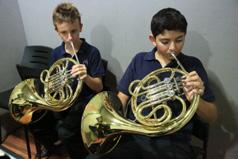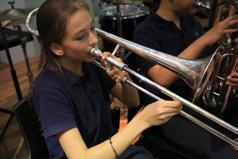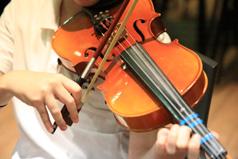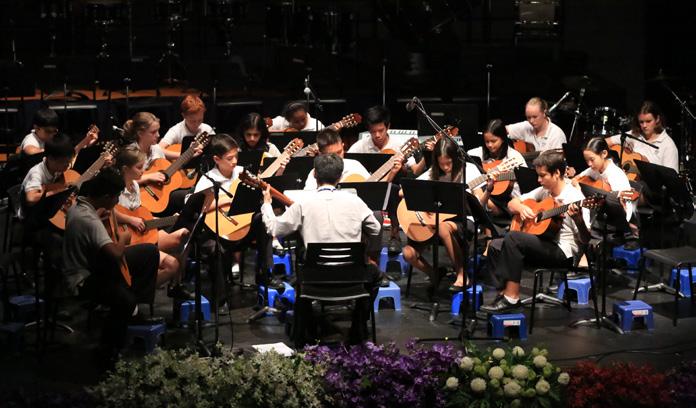
7 minute read
INSTRUMENTS EXPLAINED
Some Advice…
Students who do not play any instrument at present are encouraged to join the vocal ensemble, concert band or strings. Students who already learn an orchestral or band instrument, are encouraged to continue their instrument.
Vocal Ensemble
Voice lies at the heart of music; every instrumentalist must make his or her instrument ‘sing’. This option will suit students who prefer to use their voice as their instrument, as well as students learning an instrument or instruments privately who wish an alternative in the Key Stage 3 programme. The course will cover tone production, posture, intonation, diction, phrasing and musical singing, reading of notation, singing in parts, ensemble togetherness in a variety of styles from classic to pop. Students will develop skills they can use both as vocal soloists and in choirs and a capella groups, and an interest and ability which will be life-long.
Concert Band

Instrument Flute
Clarinet
Description A very popular instrument of the woodwind family and is the highest pitched instrument in the Concert Band. It is suitable for all students as long as they like the high sound produced. As the sound is produced over a tone hole, no problems arise due to braces. Flute players should have a slight “frown” to the upper lip with NO tear drop shape in the middle. Flute tones are produced by being able to focus an extremely small airstream to an exact location on the tone hole. The tear-drop-shaped lip will make it difficult to direct the air precisely. Flute players should also have agile fingers for moving this multi-keyed instrument through a fast musical passage. Students with extreme overbites (receded jaw) should avoid choosing the flute as this makes it difficult to produce quality sounds. Students who excel on the flute can audition to play the oboe, bassoon or piccolo in Year 8 and 9.
The clarinet uses a single reed and a mouthpiece to produce the sound. It has a lower and mellower sound than the flute and is a versatile and rewarding instrument. One necessity of clarinet tone production is the ability to make the chin flat. Orthodontia is okay, but a pronounced underbite may cause sound production problems as it will be hard to place the mouthpiece in the proper position. Students who excel on the clarinet can audition to play the oboe, bassoon, piccolo or bass clarinet in Year 8 and 9.
Saxophone

Trumpet

French Horn The saxophone uses a single reed and has characteristics similar to a clarinet. However, although it is made of brass instead of wood, it is still considered to be part of the woodwind family; it has a more robust sound than the clarinet and is used in concert, pop and jazz bands alike. Students who excel on the saxophone can audition to play the oboe, bassoon, tenor saxophone or baritone saxophone in Year 8 and 9.
The trumpet is the smallest member of the brass family and produces sounds through lips buzzing on a mouthpiece. The trumpet often acts as a leader in the band, plays the highest brass part and often plays the melodic line. As the mouthpiece is the smallest, students with thick lips sometimes have some difficulty producing a characteristic trumpet sound. While orthodontia is somewhat troublesome to a trumpet player, it is not impossible to make good sounds with braces. A slight overbite is okay, but an underbite can severely hinder progress on the trumpet.
The approach to playing the French horn is similar to that of the trumpet. However, the French horn produces a much warmer and mellow tone; perhaps the most beautiful tone of all brass instruments. Like the trumpet, players with thinner lips usually have more success with this instrument. Orthodontia can be troublesome for a horn player, but it is not impossible to make good sounds with braces. A slight overbite is okay, but an underbite can severely hinder progress on the horn.
Baritone Horn (Euphonium)

Trombone Pitch recognition is very helpful when playing the French horn as it assists beginning players in playing the correct pitches. This instrument is a particularly good choice for motivated and high achieving students who play piano, sing in choir or take voice lessons. Being part of the brass family and larger than the trumpet, the baritone horn produces a lower, rounder and warmer tone. As the mouthpiece on the baritone is larger than the trumpet and French horn, students with average to thick lips find it easier to produce a full, characteristic sound. The baritone is a good choice for students who like the sound of a brass instrument but will likely have braces.
The trombone is the only instrument in the brass family that uses a slide to play different notes. The mouthpiece and tone produced is very similar to that of the baritone. Furthermore, like the baritone, the trombone is a good choice for students with average to thick lips who will likely have orthodontic work. The trombone is a very flexible instrument and can play in concert band, orchestra and jazz band.
Tuba As the lowest pitched brass instrument in the band, the tuba plays the very important role of providing the bass line. The tuba’s role in the concert band is similar to the bass guitar in a rock/pop band. Like the trombone and baritone, fuller lips help produce the low tones necessary. Due to the size of the instrument, students are allocated an instrument to keep at home for daily practice. This eliminates the need to carry a large instrument to school.
Percussion

The tuba provides the musical foundation for the band and plays a ‘behind the scenes’ leadership role. This instrument is suitable for a motivated, high achieving student. The percussion section consists of a snare drum, bass drum, glockenspiel, cymbals, timpani, etc. Percussion provides the rhythmic drive and plays an extremely important role in the ensemble. The percussion section is perhaps the most select, hand-picked section of the band. Students with a background in piano lessons and extremely high gross and fine motor skills will be considered for percussion. An innate sense of rhythm and good hand/eye coordination are desirable.
Strings
Initially, string instruments may take a bit more time, but once basic posture and fundamentals are achieved, students can enjoy producing a good sound in a variety of musical styles. String instruments provide students with superb training in both fine and gross motor coordination and ear training. The ensemble experience teaches them to work collaboratively and to listen and learn from one another.
Instrument

Violin
Description
The violin is a very expressive instrument and the backbone of the orchestra. To succeed with the violin, as with any string instrument, good coordination and an ability to match pitch will be important.
Viola

Cello
Double Bass The viola is similar to the violin, but sounds a fifth lower, suiting students who like this more mellow sound. Although full size violas are larger than violins, requiring larger spacing between notes, the school has small violas suitable for students with small hands.
The cello has a wonderful tenor sound, with which many people fall in love! The school has cellos of different sizes to suit student size. Students studying cello will need to bring the instrument to school once a week, on the day of the lesson. Transporting a cello in a school bus is not a problem.
The Double Bass is a big instrument and thus suits students with reasonably good physical strength. It has a wonderful deep and powerful sound, and no ensemble is complete without one. Students studying double bass should not worry about transporting the instrument to and from school as we will provide you with a double bass to keep at home. We have seen very successful double bass players who are quite small, so do not assume you need to be a giant in order to learn this instrument. Apart from the string ensemble, the double bass provides skills which are later useful for Jazz or Pop music.
Guitar Ensemble
Students need to be good at deciphering notations, as guitar notation is quite complex and polyphonic. Also good coordination in both hands is needed. The course is in classical guitar music, rather than rock or pop - very rewarding when taken seriously. This option is limited to those already playing at an Intermediate level, rather than beginners.

Thai Ensemble
Instrument Ranard
Khim
Description This the Thai xylophone. Most students will already have experience on “Western” xylophones. Suitable for any student, this ensemble includes extension opportunities on other Thai instruments such as the Gong Wong Yay and Lek (Gong circle).
Stringed dulcimer, played with beaters. It is a popular instrument.
Sor Oo / Duang Two-stringed instrument played with a bow.
Gong Wong A circle with 18 tuned gongs played with mallets.


Bangkok Patana School Tel: +66(0) 27785 2200 Email: admissions@patana.ac.th www.patana.ac.th


